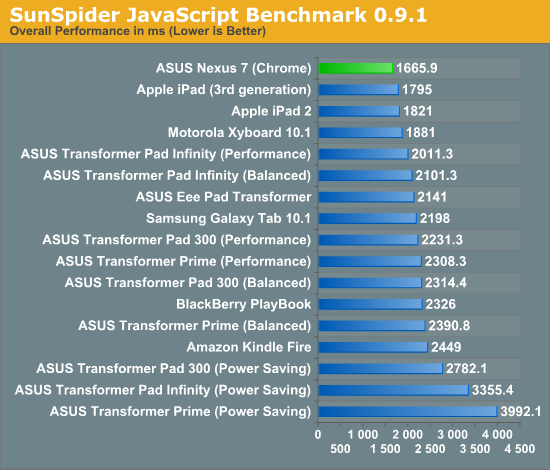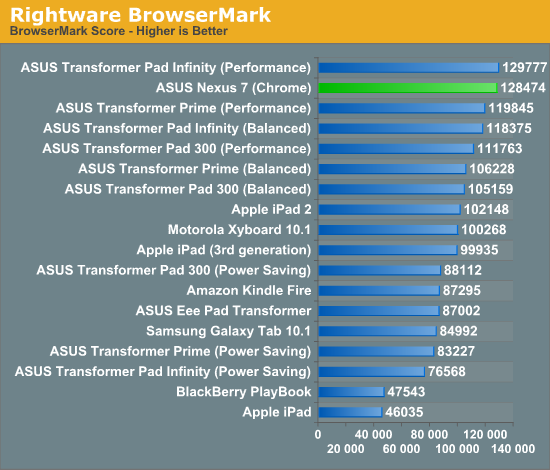The Google Nexus 7 Review
by Anand Lal Shimpi & Brian Klug on July 26, 2012 11:35 AM ESTThe SoC & Performance
While Amazon chose TI's OMAP 4 for the Kindle Fire, Google and ASUS picked arguably the second best SoC on the market today: NVIDIA's Tegra 3. Keep in mind that high-end ARM SoCs generally sell in the $14 - $25 range per chip, which a fabless semiconductor manufacturer has to split with a foundry. The result is a far cry from the margins NVIDIA is used to making on high-end discrete GPUs. I suspect a desire to make good use of all functional Tegra 3 parts that come back from the fab is the reason why we have so many variants of the Tegra 3.
To date we've seen three Tegra 3 SKUs used in tablets: T30L, T30 and T33. Factor in the smartphone SKUs (AP30, AP33) and it's already a pretty healthy collection for a single chip. The main differences between the 30L, 30 and 33 parts are voltages and clock speeds. I've shown this table in previous articles but I present it here again since T30L is what's in the Nexus 7:
| NVIDIA Tegra 3 | |||||||
| CPU Cores | Max CPU Clock (1 core active) | Max CPU Clock (multiple cores) | GPU Cores | Max GPU Clock | |||
| NVIDIA Tegra 3 (T33) | 4+1 | 1.7GHz | 1.6GHz | 12 | 520MHz | ||
| NVIDIA Tegra 3 (T30) | 4+1 | 1.4GHz | 1.3GHz | 12 | 520MHz | ||
| NVIDIA Tegra 3 (T30L) | 4+1 | 1.3GHz | 1.2GHz | 12 | 416MHz | ||
The loss in performance compared to T30/T33 is marginal at best, at least for most consumer use cases. Four Cortex A9s running at up to 1.3GHz is definitely quick enough for the types of applications you'll run on the Nexus 7. Things can always be faster, but like the Kindle Fire's OMAP 4, the Nexus 7's T30L is good enough for now. Give it another year and we'll see something even faster at this price point. That's the downside of buying anything in the tablet/smartphone space these days unfortunately.
| ASUS Android Tablet Memory Choices | ||||||
| TF Prime | TF Pad 300 | Nexus 7 | TF Pad Infinity | |||
| Memory Capacity | 1GB | 1GB | 1GB | 1GB | ||
| Memory Type | DDR2-1000 | DDR3L-1333 | DDR3L-1333 | DDR3-1600 | ||
| Memory Bandwidth | 4.0GB/s | 5.3GB/s | 5.3GB/s | 6.4GB/s | ||
ASUS selected 1GB of DDR3L-1333 memory for the Nexus 7. This gives it more memory bandwidth than any of the Transformer series of tablets, with the exception of the Transformer Pad Infinity. Since the Tegra 3 SoC only has a single channel memory interface, ASUS had to rely on higher frequency memory to deliver sufficient bandwidth.
Note that the browser performance tests below paint a very good picture for the Nexus 7's performance because Android 4.1 replaces the default web browser with Chrome, with a much faster javascript engine.













118 Comments
View All Comments
dcollins - Thursday, July 26, 2012 - link
Not everyone is like you.All my music lives in Spotify and I stream the vast majority of the movies/tv shows I watch. Plus, 90% of my tablet time is spent reading or browsing anyways.
Expandable storage is nice, but it certainly is not a blocking issue for my usage.
CeriseCogburn - Sunday, July 29, 2012 - link
I love that how all the screaming for future proof options is out the window.Steve Jobs loves it too.
robinthakur - Tuesday, July 31, 2012 - link
Agree. I think the Retina Macbook is the poster boy for this though. Not having upgradeable ram on a £2500 laptop is pretty inexcusable. What if I need more than 16GB to run virtual machines etc? It's the only thing which keeps me from buying one.dmyster - Thursday, July 26, 2012 - link
well, I have a pretty good set up at home for streaming most media to tablets and media devices. The extra 50 bucks for 16 gig was not worth it to me since I will not be traveling with it. I can watch all my movies, listen to all the songs in my library and read books. There are some decent apps - stock ticker, netflix, skype to mention a few. For 200 bucks it is a good deal if you can do without the extra storage or a sd card which I can...Impulses - Friday, July 27, 2012 - link
Root it, install Stickmount, use any removable media with a USB OTG cable. If there was a better 7" alternative for $50 more or even $100 more that comment might make more sense... But as it is, the Nexus 7 is still a fantastic device and unless you're very tech averse the lack of expandable storage out of the box really isn't a big deal...I'd even take a gamble that most people who'd balk at rooting the thing will probably never store enough media or games on it to really have an issue with 16GB, the 8GB model will be tight if you start to download big games left and right tho.
CeriseCogburn - Sunday, July 29, 2012 - link
Boy you have no clue on the public and general end users.Let me help.
They are utterly clueless, and when faced with storage constraints, they have no idea what to do, and deleting for space is above their user skills.
That's the vast majority of purchasers.
TheJian - Wednesday, August 1, 2012 - link
Don't confuse apple users with Android users :)We don't call them SHEEPLE for nothing ;)
A large portion of Android users are above the norm and believe in using their devices for more than Steve Jobs every believed you should get away with.
NoNeedForMonkeys - Saturday, August 4, 2012 - link
Perhaps you should burn every iOS device for not having expandable storage.lunarx3dfx - Thursday, July 26, 2012 - link
http://www.androidcentral.com/why-nexus-devices-ha...That article talks about the lack of SD cards, and honestly it makes sense to me. Also, keep in mind that they do have a 16 GB Nexus 7 available for purchase. Although, I think it's currently sold out.
CeriseCogburn - Sunday, July 29, 2012 - link
Of course it's sold out.